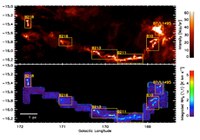Imaging Filaments
 The authors present deep NH3 observations of the L1495-B218 filaments in the Taurus molecular cloud covering over a 3° angular range using the K-band focal plane array on the GBT. The L1495-B218 filaments form an interconnected, nearby, large complex extending over 8 pc. They observed NH3 (1, 1) and (2, 2) with a spectral resolution of 0.038 km/s and a spatial resolution of 31''. Most of the ammonia peaks coincide with intensity peaks in dust continuum maps at 350 and 500 μm. Physical properties are deduced by fitting a model to the observed spectra. These yield gas kinetic temperatures of 8–15 K, velocity dispersions of 0.05–0.25 km/s, and NH3 column densities of 5 x 1012 to 1 x 1014 cm−2. About 25% of the clumps are gravitationally bound and associated with star formation. The unbound clumps are mostly pressure confined. These data suggest that a dense core may form as a pressure-confined structure, evolve to a gravitationally bound core, and collapse to form a protostar.
The authors present deep NH3 observations of the L1495-B218 filaments in the Taurus molecular cloud covering over a 3° angular range using the K-band focal plane array on the GBT. The L1495-B218 filaments form an interconnected, nearby, large complex extending over 8 pc. They observed NH3 (1, 1) and (2, 2) with a spectral resolution of 0.038 km/s and a spatial resolution of 31''. Most of the ammonia peaks coincide with intensity peaks in dust continuum maps at 350 and 500 μm. Physical properties are deduced by fitting a model to the observed spectra. These yield gas kinetic temperatures of 8–15 K, velocity dispersions of 0.05–0.25 km/s, and NH3 column densities of 5 x 1012 to 1 x 1014 cm−2. About 25% of the clumps are gravitationally bound and associated with star formation. The unbound clumps are mostly pressure confined. These data suggest that a dense core may form as a pressure-confined structure, evolve to a gravitationally bound core, and collapse to form a protostar.
View Paper: An Ammonia Spectral Map of the L1495-B218 Filaments in the Taurus Molecular Cloud. I. Physical Properties of Filaments and Dense Cores, Young Min Seo (Arizona), Yancy L. Shirley (Arizona), Paul Goldsmith (JPL), Derek Ward-Thompson (Central Lancashire), Jason M. Kirk (Central Lancashire), Markus Schmalzl (Leiden), Jeong-Eun Lee (Kyung Hee), Rachel Friesen (Toronto), Glen Langston (NSF), Joe Masters (NRAO), Robert W. Garwood (NRAO), 2015 ApJ, 805, 185 (June 2015).




Connect with NRAO